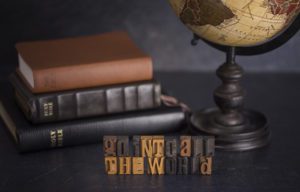filter posts:
Date
Go Tell it on the Mountain
 Let me give you a mini lesson this morning on the authenticity of Scripture and how we know it is the Word of God that we can trust and build our lives upon. Look at Mark 8:8. Do you see the script after verse 8 that says, “Some of the earliest manuscripts do not include 16:9-20”? You see the same at the end of John 7, because the story of the woman caught in the act of adultery is not in the oldest manuscripts of John’s gospel. What does that mean, “earliest or oldest” manuscripts? The Gospel writers just wrote one manuscript each, right? That’s right, but we do not have any of the original manuscripts. We only have copies. There are more than 25,000 copies of the New Testament, complete or fragmented, some within 20 years of the originals, more than any other ancient writing. Homer’s Iliad is a distant second with a mere 643 manuscript copies, and with the oldest copy dated at 500 years after the original.
Let me give you a mini lesson this morning on the authenticity of Scripture and how we know it is the Word of God that we can trust and build our lives upon. Look at Mark 8:8. Do you see the script after verse 8 that says, “Some of the earliest manuscripts do not include 16:9-20”? You see the same at the end of John 7, because the story of the woman caught in the act of adultery is not in the oldest manuscripts of John’s gospel. What does that mean, “earliest or oldest” manuscripts? The Gospel writers just wrote one manuscript each, right? That’s right, but we do not have any of the original manuscripts. We only have copies. There are more than 25,000 copies of the New Testament, complete or fragmented, some within 20 years of the originals, more than any other ancient writing. Homer’s Iliad is a distant second with a mere 643 manuscript copies, and with the oldest copy dated at 500 years after the original.
Some copies differ in a word here, or a sentence there, or even a whole section, as we see in this text. Why is that? If you lived in Israel in A.D. 60 and you wanted a copy of Mark’s Gospel, how would you get it? You couldn’t run down to Straight Street in Damascus and pop into the Office Depot with Mark’s original manuscript. You had to sit down with it and painstakingly write it out, one word at a time. And what if you made a copy error, as many did? Well, you had a copy, but it was not a perfect copy, and if others made copies from your copy, they would not be perfect either, and they may make other errors in transcribing your copy! How do we know that we have the genuine text, or at least one that we can trust to be accurate in all things that matter? An article by Craig Blomberg in the Gospel Coalition states that there were an average of 16 variations per manuscript, and “the vast majority of these involved variations in the spelling of words; the use or non-use of an article, conjunction or particle; or slight variations in syntax. The only two that involve more than one or two verses are Mark 16:9-20 and John 7:53-8. Most importantly, no doctrine or ethical teaching of Christianity depends solely on one or more disputed texts.”
The first 6 verses in the “disputed section” form a mosaic of three resurrection appearances of Jesus, built around the theme of calling the disciples from unbelief to belief. The first reflects John’s account of Mary Magdalene weeping outside the tomb, telling the angels, “They have taken away my Lord, and I do not know where they have laid him.” She then turned around and saw Jesus, but thought he was the gardener. Until he called her by name: “Mary.” She went and told the disciples, “I have seen the Lord.” Mark’s gospel says they heard her, but “they would not believe it.”
The second story reflects Luke’s gospel account, where two followers of Jesus, not two of the eleven apostles, meet Jesus on a country road. Luke tells us they were on the road to Emmaus. I love that story. They didn’t recognize the risen Savior, and they couldn’t believe that this guy walking with them didn’t know what had happened. One of them, Cleopas, said to Jesus, “Are you the only visitor to Jerusalem who does not know these things that have happened…?” Ha! Jesus is the only one who truly knows what happened. He reveals himself to them in the breaking of bread and then vanishes. They raced back to Jerusalem and told the eleven, “The Lord has risen indeed.” Mark says, “but they did not believe them.”
In the third story, Jesus appears to his eleven disciples and rebukes them for their “unbelief and hardness of heart, because they had not believed those who saw him after he had risen.” Three stories, three witnesses to the risen Savior, in ascending order of reliability, according to Jewish culture: a woman, two men, and Jesus Himself. The message is clear. Jesus Christ is risen from the dead. Believe it. But not only that.
Go tell it on the mountain. And, everywhere else.
November 14, 2021
The Fulfillment of Passover
 We are preparing to celebrate a big holiday this month where we look back to God’s providence in the formation of the United States. The Pilgrims landed at Plymouth Rock on November 11, 1620. After a harsh winter and the loss of 45 of the 102 who came over on the Mayflower, 1621 brought hope through Squanto, an Indian who spoke English and was a follower of Jesus. He taught the Pilgrims how to fertilize the soil and produce a healthy crop. He also translated for the Pilgrims and bridged a relationship of trust with the Wampanoag tribe. Massasoit, the chief of the Wampanoag, signed a treaty with the Pilgrims in exchange for their help against the feared Narragansett tribe. Governor William Bradford called the Pilgrims together for a time of giving thanks to God, and Massasoit and about 90 other Indians joined in the feast. November 25th this year is not Turkey Day, but a day of looking back, a day of giving thanks for God’s grace on this land. It prepared the way for the birth of a new nation, just as Passover did for Israel.
We are preparing to celebrate a big holiday this month where we look back to God’s providence in the formation of the United States. The Pilgrims landed at Plymouth Rock on November 11, 1620. After a harsh winter and the loss of 45 of the 102 who came over on the Mayflower, 1621 brought hope through Squanto, an Indian who spoke English and was a follower of Jesus. He taught the Pilgrims how to fertilize the soil and produce a healthy crop. He also translated for the Pilgrims and bridged a relationship of trust with the Wampanoag tribe. Massasoit, the chief of the Wampanoag, signed a treaty with the Pilgrims in exchange for their help against the feared Narragansett tribe. Governor William Bradford called the Pilgrims together for a time of giving thanks to God, and Massasoit and about 90 other Indians joined in the feast. November 25th this year is not Turkey Day, but a day of looking back, a day of giving thanks for God’s grace on this land. It prepared the way for the birth of a new nation, just as Passover did for Israel.
The first Passover took place on the same night that the final plague took the lives of the firstborn children in Egypt. God instructed Moses and Aaron to tell the children of Israel to take a lamb for each household, or to combine two smaller households if need be. Take a lamb without blemish and kill it at twilight on the 14th day of that month. They were to take blood from the lamb and put it on their doorposts and lintels, and they were to eat the lamb with unleavened bread and bitter herbs (Exodus 12). No time for bread to rise, for they must eat in haste, as the Lord would send the angel of death that night to strike the firstborn in Egypt. God said, “I will execute judgments: I am the Lord.” Those whose houses were marked by the blood of the lamb would be passed over. They would be saved from judgment. It was a picture of God’s amazing grace, and of substitutionary atonement. The lamb had to die in their place, and the blood of the lamb saved them from death. You may know that the Passover looks forward, points forward to its fulfillment in Jesus, the Lamb of God who takes away the sins of the world. But I would suggest to you that the Passover also looked back to the Garden of Eden, where the first substitutionary atonement took place. After Adam and Eve had sinned, “the Lord God made for Adam and his wife garments of skin and clothed them.” (Genesis 3:21) Those clothes made of animal skins required a death, but were temporary coverings, just as the sacrifice of countless lambs and goats and oxen were as well. But when God cursed the serpent in the garden, He spoke of the final and perfect sacrifice of his Son. “I will put enmity between you and the woman, and between your offspring and her offspring; he shall bruise your head, and you shall bruise his heel.” (Genesis 3:15) This is called the “Protoevangelium,” or the first announcement of the gospel. Satan would be finally and forever defeated by Jesus, and the brothers and sisters of Jesus, his followers, will be forever with him.
Back in the upper room, now, for the final fulfillment of Passover. Jesus said to his disciples in Luke 22, “I have earnestly desired to eat this Passover with you before I suffer.” This Passover. With you. Who is Jesus sharing this Passover and the first Lord’s Supper with? His family. Remember in Mark 3 when Jesus was teaching and someone interrupted him to say that his mother and brothers were outside, looking for him? Jesus answered, “Who are my mother and my brothers?” And he looked around at the people sitting with him and said, “Here are my mother and my brothers! For whoever does the will of God, he is my brother and sister and mother.”
When we gather to worship Jesus, we gather as family. When we pray, “Our Father, who is in heaven,” we pray as family. When we take communion together, as we will in a few minutes, we do so as family. Brothers and sisters of Christ, our elder brother, together remembering the Savior who died in our place, looking back at the cross and looking forward to eternity with him. We are family. Just as the Passover was eaten as families, so we eat the Lord’s Supper each month as a family. And the HEAD of the family is here with us. It reminds us each month that we are neither independent or rugged individuals, nor are we struggling alone as singles or as separated families. We are one family.
November 7, 2021
